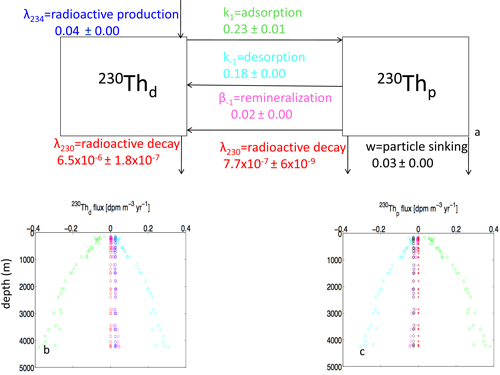Inference about rates of thorium and particle cycling in the ocean water column
Insoluble thorium (Th) isotopes are particle reactive while their radioactive parents are fairly soluble. This difference of behaviour has allowed chemical oceanographers to use Th isotopes to develop understanding about the scavenging of particle reactive elements and the cycling of particles in the water column. However, many prior models rely on numerous assumptions. Among these assumptions is vertical uniformity of the rate parameters governing sorption reactions and particle processes in the mesopelagic zone and in the deeper regions of the water column (Th adsorption and desorption, particle remineralization and settling speed, etc.).
In this work, Paul Lerner and co-authors (2016, see reference below) use Th and particle data collected at station GT11-22 of the GEOTRACES North Atlantic transect (section GA03) in order to test two models of Th and particle cycling: a conventional one that assumes uniform rate parameters and another one that allows the rate parameters to vary with depth. They show that the second model leads to a significantly better fit to the data, thereby challenging the assumption of parameter uniformity in the conventional model. Moreover, by combining the second model with the data, they diagnose the various terms in the depth-dependent Th isotope budgets at GT11-22, showing in particular that the behaviour of 230Th is dominated by a balance between adsorption and desorption over most of the water column.

Reference:
Lerner, P., Marchal, O., Lam, P. J., Anderson, R. F., Buesseler, K., Charette, M. A., Edwards, R. L., Hayes, C. T., Huang, K-F., Lu, Ya., Robinson, L F., Solow, A. (2016). Testing models of thorium and particle cycling in the ocean using data from station GT11-22 of the U.S. GEOTRACES North Atlantic section. Deep Sea Research Part I: Oceanographic Research Papers, 113, 57–79. doi:10.1016/j.dsr.2016.03.008
